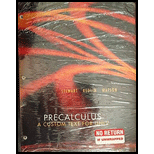
To calculate: The factors of the trinomial
Answer to Problem 73E
The factors of the trinomial
Explanation of Solution
Given information:
The expression
Formula used:
The special product formula of perfect square to multiply a polynomial with itself which is mathematically expressed as,
To find the factor of the trinomial of the form
Calculation:
Consider the given expression
Recall the special product formula of perfect square to multiply a polynomial with itself which is mathematically expressed as,
Apply it,
The simplified form of
Recall that to find the factor of the trinomial of the form
So, find
Here,
Thus, the factors of trinomial
Chapter 1 Solutions
Precalculus - A Custom Text for UNLV
- 7. Consider the following parametric curve: x = sint, y = 2 cost, for 0 ≤t≤ a) Eliminate the parameter to find a rectangular equation for the curve. b) Use the parametric equations to find the slope of the tangent line when t = c) Use the parametric equations to set up an integral to represent the arc length of the curve. You do not need to evaluate the integral.arrow_forward10. Consider the polar equation r = sin² (2) a) Find the (rectangular) equation of the tangent line when 0 => b) Set up an integral to represent the arc length of the curve for 0arrow_forward2. Which of the following differential equations has the direction field shown? Explain your answer and support it with calculations. Full credit will not be given without sufficient justification. a) y' = x + 2y 31 12 b) y' = y - ¹× c) y' = (x + 1)(y+1) / 1 +-2 1-311 Harrow_forward8. Graph the polar equation r = 4 cos 30. Show work to fully justify your graph. 2 2 2 2arrow_forward9. Consider the cardioid r = 1 + cos 0. a) Set up an integral to represent the area inside the cardioid. b) Evaluate the integral you set up in part (a).arrow_forwardFree Response Question-1 Calculator NOT Allowed 2 D 2 E F 4 Graph off G t -S g(x) <-4 -2 2 G 1 4 8 2 0 3 -1 5 3 7 -2 8 -12 B The function f is given by the graph above left. Selected values of the function g are given in the table above right. The function f is modeled by a polynomial of degree n with leading coefficient a. There are no zeros beyond the interval shown on the graph. Answer the following questions regarding these functions. A. What is the degree, n of the polynomial based on the graph? Give a reason for your conclusion. B. For the function f(x) = ax" what can you determine about the sign of a? How do you know? C. On what interval(s) is the rate of change of f (x) positive and decreasing? Explain how you know. D. The function g is modeled by a polynomial of degree m. Determine the minimum value of m. Justify your answer. E Find the average rate of change of g on the interval 1≤ x ≤ 3.arrow_forwardIn the following exercises, evaluate each definite integral using the Fundamental Theorem of Calculus, Part 2. 170. 171. 2 -1 3 ། - dx (2² – 3x) d L₁ (2² + (x² + 3x - ! - 5) dxarrow_forwardA region is bounded by y = 0, y = x³, and x = 1. Find the x coordinate of the center of mass. Round off to two decimal places. Remember if A is the area of the region then 1 x = ffxdydx Aarrow_forwardy=ln((1+e^x)/(1-e^x)) find the derivative.arrow_forwardfind the curvature when t = 0.5. round off to two decimal places. r(t) = <t, 1/2t^2, 1/2t^2>arrow_forwardfind the speed of the object when t=2. Give the answer in decimal form and round to 2 decimal places. r(t) = <3t-1,t^2>arrow_forward3. Evaluate. Leave your answer in simplest exact form: 8 x²+x+1 √x dxarrow_forwardarrow_back_iosSEE MORE QUESTIONSarrow_forward_ios
 Calculus: Early TranscendentalsCalculusISBN:9781285741550Author:James StewartPublisher:Cengage Learning
Calculus: Early TranscendentalsCalculusISBN:9781285741550Author:James StewartPublisher:Cengage Learning Thomas' Calculus (14th Edition)CalculusISBN:9780134438986Author:Joel R. Hass, Christopher E. Heil, Maurice D. WeirPublisher:PEARSON
Thomas' Calculus (14th Edition)CalculusISBN:9780134438986Author:Joel R. Hass, Christopher E. Heil, Maurice D. WeirPublisher:PEARSON Calculus: Early Transcendentals (3rd Edition)CalculusISBN:9780134763644Author:William L. Briggs, Lyle Cochran, Bernard Gillett, Eric SchulzPublisher:PEARSON
Calculus: Early Transcendentals (3rd Edition)CalculusISBN:9780134763644Author:William L. Briggs, Lyle Cochran, Bernard Gillett, Eric SchulzPublisher:PEARSON Calculus: Early TranscendentalsCalculusISBN:9781319050740Author:Jon Rogawski, Colin Adams, Robert FranzosaPublisher:W. H. Freeman
Calculus: Early TranscendentalsCalculusISBN:9781319050740Author:Jon Rogawski, Colin Adams, Robert FranzosaPublisher:W. H. Freeman
 Calculus: Early Transcendental FunctionsCalculusISBN:9781337552516Author:Ron Larson, Bruce H. EdwardsPublisher:Cengage Learning
Calculus: Early Transcendental FunctionsCalculusISBN:9781337552516Author:Ron Larson, Bruce H. EdwardsPublisher:Cengage Learning





